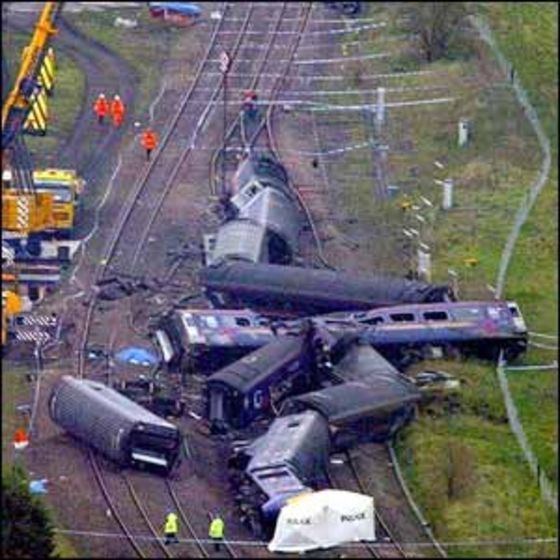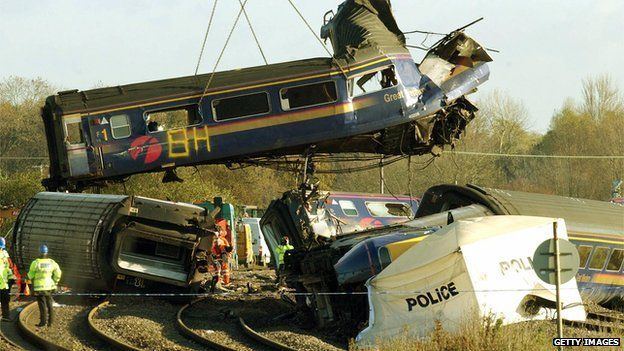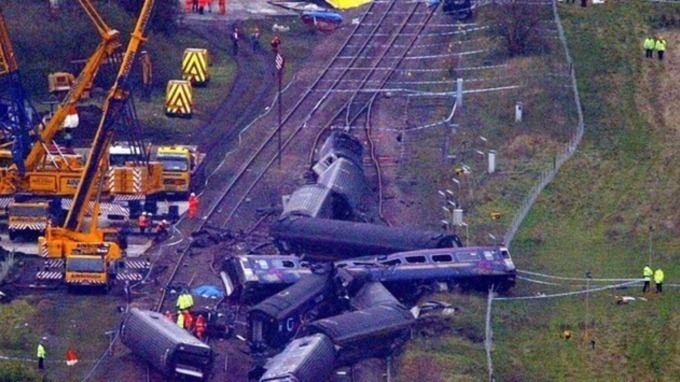Time 18:12 Cause Obstruction on line Date 6 November 2004 Injuries 71 | Country United Kingdom Passengers 180–200 Operator Great Western Railway Trains 1 | |
 | ||
Total number of deaths 7 (including the driver of the car involved) Similar Tebay rail accident, Great Heck rail crash, Southall rail crash, Hatfield rail crash, Cairns Tilt Train derailment | ||
Ufton nervet rail crash
The Ufton Nervet rail crash was a collision between a train and car near Ufton Nervet, Berkshire, England, in 2004. Seven people, including the drivers of the train and the car, were killed.
Contents
- Ufton nervet rail crash
- Collision
- Background
- Site
- List of fatalities
- Investigation
- Royal Humane Society awards
- Memorial
- Replacement bridge
- Further incidents
- References

Collision

On 6 November 2004 at 18:12 GMT, the 17:35 service from London Paddington to Plymouth, an InterCity 125 (HST) led by a Class 43 power car (43019) collided with a stationary car at an automatic level crossing close to the rural West Berkshire village of Ufton Nervet. The inquest concluded that the crash was caused by Brian Drysdale, a chef at Wokefield Park Hotel 3 miles (4.8 km) away, committing suicide by parking his car on the crossing.

All eight coaches derailed and the rear of the 220-metre (720 ft) InterCity 125 train came to rest about 100 m (110 yd) beyond the crossing. Seven people were killed in the crash: the car's driver, the driver of the train, and five of its passengers. About 200 people were on board at the time of the incident (official estimates are around 180–200). About half of these were injured, 12 of them seriously. Eleven people were cut free from the wreckage. The high structural integrity of the Mark 3 coaches prevented a much higher death toll, plus the fact that the more lightly loaded first-class coaches were at the leading end of the train.

More than 20 ambulances from five counties and 14 fire engines attended the crash. Injured passengers were first helped at the Winning Hand pub, 300 m north. After the collision survivors in some carriages used emergency hammers to break the train windows to escape. The accident occurred at night, and so passengers used emergency glow sticks and their mobile phones to provide some light. 61 injured passengers were taken variously to the Royal Berkshire Hospital in Reading and the North Hampshire Hospital in Basingstoke. Other passengers were treated at the scene and the Winning Hand pub for minor injuries.
The crash, investigation and necessary repairs blocked the direct railway between London and the southwest until the morning of 16 November 2004. The line reopened under temporary speed restrictions to allow the bedding in of ballast. In the meantime long-distance trains operated via Swindon and Westbury and local services were replaced by rail and bus shuttles.
Background
In the United Kingdom, automatic half-barrier level crossings (AHB/AHBC) are used on roads where traffic is unlikely to queue across the crossing and where rail line-speed is not more than 100 mph (160 km/h). Other than the train driver's line of sight, which is less effective at night, railway signalling control and train drivers have no means of knowing whether this level crossing (and many others) are clear. Half barriers close the crossing to road traffic but allow any road user on the crossing to escape without the need for a local controller to raise the barriers.
Site
The crash was at a level crossing on the narrow lane linking the village of Ufton Nervet to the Bath Road (A4), about 300 m (330 yd) from their junction. Most of the surrounding land is rural including all of the land immediately by the railway.
List of fatalities
Investigation
An investigation was carried out by Thames Valley Police and British Transport Police. A preliminary report by the Health and Safety Executive indicated that the car stopped on the level crossing before any warnings and failed to react to the barrier alarm sequence. A minor deflection of the stationary car to one side by the train derailed the forward bogie, which continued to travel at about 25° to the rails until reaching the points at the start of a loop. At this point the power car derailed completely, causing the remainder of the train to derail.
The Rail Safety and Standards Board published a preliminary report on 1 February 2005 that stated:
The RSSB report made recommendations including improving emergency communications at the level crossing and moving a set of points whose position was a factor in the train's derailment. Network Rail implemented all the safety recommendations.
On 1 June 2005 it was announced that an inquest into the crash would be held at the Guildhall in Windsor, Berkshire. The inquest was expected to last 12 days, starting on 17 October 2005. A delay ensued over whether the families of the victims should be granted legal aid. The inquest finally began in October 2007. A policeman who had witnessed the crash, PC Brazier, testified at the inquest. He told the jury that he believed the crash was caused by a suicide attempt. The Forensic Accident Investigator, David Price, told the inquest that he had been able to determine that the car had been parked on the level crossing with its engine switched off, the handbrake fully applied, the vehicle's lights switched off, the steering on a partial left-hand turn (which was not consistent with driving across the crossing), and that its fuel tank still contained at least 8 litres (about 2 gallons) of petrol.
On 1 November 2007 the inquest returned the verdict that the crash was caused by Brian Drysdale's suicide. A support network, the Ufton Nervet Train Crash Network, was set up for survivors and relatives of the victims.
Royal Humane Society awards
In 2005 the Royal Humane Society awarded its Bronze Medal to two passengers who were on the train: salesman Brian Kemsley and Royal Marines company sergeant major Tom McPhee. The two men found nine-year-old Louella Main and her mother Anjanette Rossi, both of whom had been thrown out of the train by the force of the crash. Rossi was dead but Kemsley testified to the 2007 inquest:
We came across a young person on the tracks and me and Tommy could see blood coming from the little girl's head and she had a little pulse. We were trying our hardest to keep her going.
Despite the men's efforts Main died of her injuries. Kemsley then found a clergyman who had been a passenger on the train, and got him to walk back to the bodies to say a prayer. McPhee also found injured passenger Sharmin Bacchus trapped in the wreckage, and kept her conscious until she was freed.
Memorial
Beside the level crossing a small gravelled "Area of Reflection" has been created with two wooden benches facing an engraved steel memorial plaque remembering all people affected by the collision. Also, on what would have been his 55th birthday, First Great Western named power car 43139 after the driver of the train.
Replacement bridge
In July 2012 an Internet petition called for the level crossing to be replaced with a bridge. Network Rail subsequently announced that it was considering either converting the crossing to full barriers or a bridge. In March 2014, Network Rail stated that it "remained on course" to replace the level crossing "by mid-2014 or 2015". West Berkshire Council approved plans for a road bridge in August 2015, and preparatory work began the following month. On 18 April 2016, Network Rail held an official ceremony as construction began. The bridge was officially opened on 16 December 2016.
Further incidents
Since 2004 the crash there have been deaths at the crossing in 2009, 2010, 2012, and 2014. The 2010 death was found not suspicious. The Coroner's inquest into the 2012 death recorded and open verdict as there was insufficient evidence to be certain that that fatality was the result of suicide. The 2012 collision also caused injury to the InterCity 125 driver. British Transport Police concluded that the circumstances surrounding the 2014 fatality were not suspicious.
There was a near miss at the same level crossing on 4 September 2011. The Rail Accident Investigation Branch investigated the cause, which was found to be an error by a signaller working in a central location who failed to contact the train driver and the attendant at the crossing. This failure was likely due to work overload of the signaller.
